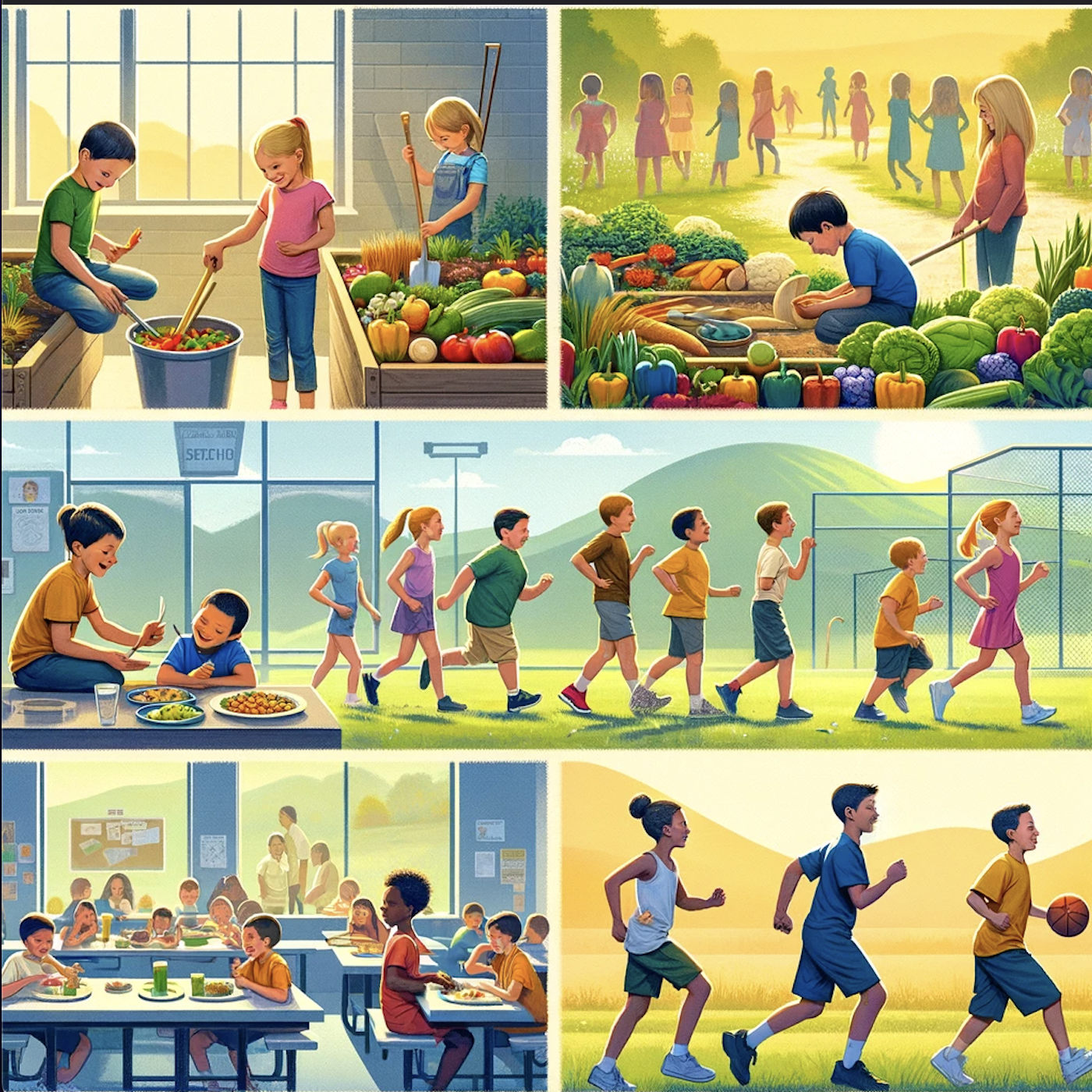Nutritional Needs & Challenges

Image Source: ChatGPT 4
When it comes to children’s overall development, one aspect that could impact their growth, cognitive abilities, and academic performance is nutrition. As children progress from elementary through high school, their nutritional requirements change. These changes correspond with their physical growth, brain development, and the demands of their evolving academic and extracurricular activities (Lally & Valentine-French, 2019). Understanding these needs can help teachers create supportive environments that encourage healthy eating habits.
In the elementary years (ages 5–10), children experience steady physical growth and need an energy-rich diet that fuels their active lifestyles and supports cognitive development. Protein is crucial for muscle and tissue development, carbohydrates provide needed energy, and healthy fats are essential for brain development. Furthermore, a variety of vitamins and minerals are needed. For example, calcium and vitamin D are critical for bone health, while iron is vital for cognitive development and the immune system (Saavedra & Prentice, 2023).
During this period, children may develop restrictive eating patterns due to food neophobia. This common fear of new foods can limit dietary variety, potentially impacting their overall nutritional intake and leading to deficiencies in certain nutrients. For example, children experiencing food neophobia might avoid fruits and vegetables, instead preferring familiar but often less nutritious foods (Białek-Dratwa, Szczepańska, Szymańska, Grajek, Krupa-Kotara, & Kowalski, 2022). Teachers can support students in overcoming neophobia by creating a positive and adventurous food environment in school, through activities such as taste tests, cooking classes, and garden programs. These activities can also be an excellent way to help students gain an understanding and appreciation of other cultures, potentially by having different students share foods that their families enjoy at home or by researching and making food related to cultures that the students have learned about in class.
When children enter middle school (ages 11–13), they start to undergo puberty, a period of rapid growth and physiological changes. This growth spurt requires increased caloric intake and specific nutrients. For instance, iron needs rise particularly in girls who have started menstruating and in boys who are experiencing rapid growth and increased muscle mass (Paris, Ricardo, & Rymond, 2019). Additionally, this is a stage when children can develop more autonomy over their food choices, making education about nutrition even more important.
Malnutrition, a condition resulting from deficiencies, imbalances, or excesses in nutrients, can have profound effects on children’s physical and cognitive development, and thus their academic performance. Undernutrition is characterized by deficiencies of energy, protein, or vitamins and minerals and may manifest as stunted growth, frequent illness due to a weakened immune system, and constant fatigue. Teachers should be particularly aware of the signs of malnutrition during elementary and middle school; during these periods, undernutrition can have a long-lasting impact on physical development. One common cause of malnutrition is food insecurity, which occurs when a family does not have consistent access to sufficient food and/or is unable to access a variety of high-quality foods (Paris, Ricardo, & Rymond, 2019). Many school districts work to address food insecurity through interventions such as backpack programs, which provide families with food for weekends and longer breaks; summer lunch programs, which open the school for lunch during the summer; or food pantries, which allow students to pick up food at school that they can bring home to their families (Kurtz, Conway, & Mohr, 2020).
By the time students reach high school (ages 14–18), their nutritional needs start to resemble those of adults. However, this period also often comes with increased physical activities, especially for student athletes, who may need more energy and protein. Middle and high school teachers should be particularly aware of the symptoms of eating disorders, as these are serious health conditions that can impact school-age children and adolescents. Eating disorders are marked by severe disturbances in eating behaviors and related thoughts and emotions. While these disorders – including anorexia nervosa, bulimia nervosa, and binge-eating disorder – are less common than general malnutrition, they can have devastating effects on children’s health and well-being. Early recognition and intervention are crucial. Signs that teachers might notice include extreme preoccupation with weight and body shape, unusual eating habits, frequent trips to the bathroom, especially after meals, and physical symptoms such as faintness or discolored teeth from vomiting (Paris, Ricardo, & Rymond, 2019).
Think, Write, Share
- What is food neophobia, and how can it impact a child’s overall nutritional intake? What strategies can teachers employ to support students in overcoming food neophobia?
- Define malnutrition and undernutrition. How can these conditions affect a child’s physical and cognitive development, and what signs might a teacher look for in elementary and middle school students that could indicate malnutrition?
- Discuss the importance of early recognition and intervention in cases of eating disorders in middle and high school students. What symptoms might teachers notice in students with eating disorders, and why is timely action crucial?
Application Challenge
Create a lesson plan for a grade of your choosing that incorporates nutrition education into a subject-focused activity (e.g., using an understanding of multiplication and division to modify the number of servings in a recipe that the class can then make together). Identify learning objectives and describe each step of the activity.